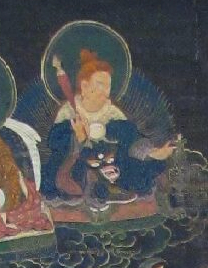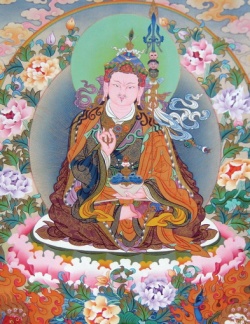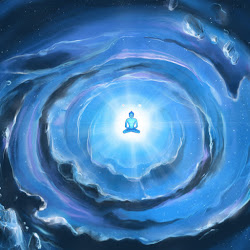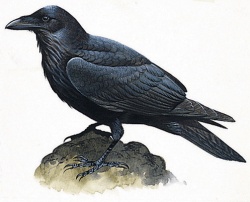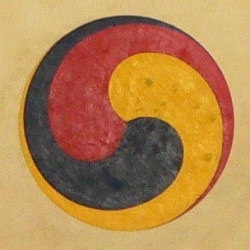Rigdzin Ngakgi Wangpo
Rigdzin Ngakgi Wangpo (Wyl. rig 'dzin ngag gi dbang po) (1580-1639) — the founder of Dorje Drak Monastery. He was the son of Changdak Tashi Tobgyal. His disciples included Khedrup Tashi Namgyal, Zurchen Chöying Rangdrol and Rigdzin Pema Trinlé. His biography was composed by the Fifth Dalai Lama.
The Third Dorje Drak Rigdzin, Ngakgi Wangpo (rdo rje brag rig 'dzin 03 ngag gi dbang po) was born at Drapchi Choding Monastery (dra phyi chos lding dgon pa) in U in 1580, the iron-dragon year of the tenth sexagenary cycle. His father, Jangdak Tashi Tobgyel (byang bdag bkra shis stobs rgyal, c.1550-1603), had been a close student of the Second Dorje Drak Rigdzin, Lekden Dorje (rdo rje brag rig 'dzin 02 legs ldan rdo rje, 1452-1565), and was known as the incarnation of Lekden Dorje's brother, Ngari Paṇchen Pema Wangyel (mnga' ris paN chen pad+ma dbang rgyal, 1487-1542), an important lineage holder in the Jangter (byang gter), or Northern Treasures tradition. His mother, Yidzin Wangmo (yid 'dzin dbang mo), was descended from the legendary kings of Chonggye ('phyong rgyas).
Legend has it that when Lekden Dorje was about to pass away, Tashi Tobgyel wept and begged him to lengthen his life. He replied that as Tashi Tobgyel loved him so much, he would take rebirth as his son. According to tradition, as soon as he was able to speak, Tashi Tobgyel's son proclaimed himself to be the reincarnation of Lekden Dorje and was able to identify his predecessor's attendants and religious objects. Tashi Tobgyel formally recognized his son as the incarnation of his own teacher -- and of the brother of his own previous incarnation -- and thus appoint him as the main lineage holder of the Jangter tradition.
Ngakgi Wangpo began studying reading and writing with his father around the age of five or six. Tashi Tobgyel gradually transmitted everything he had learned from Lekden Dorje to his son, and arranged for the transmission of whatever teaching lineages he had not received from other teachers. After gaining competence in these teachings and their practices, Ngakgi Wangpo embarked on a series of meditation retreats at various sacred places in southern Tibet connected to Padmasambhava, including Chonggye and Yarlung Sheldrak (yar klung shel brag).
Afterwards, he continued eastwards, with his father, passing through Kongpo (kong po), Mon (mon), and Kham (khams), and possibly into China. Along the way they are said to have healed the sick, tamed epidemics, and mediated conflicts. He also is said to have revealed treasure, although this might refer to minor miracles such as opening springs.
During this period central and southern Tibet was rife with sectarian conflict and political turmoil due to fighting between the then-independent kingdom of Tsang and the growing power of Geluk institutions in Lhasa. At one point, Lhawang Dorje (lha dbang rdo rje, d.u.), a powerful son of the King of Tsang, Zhingzhak Tseten Dorje (zhing zhag tshe brtan rdo rje, d.u.), ended their family's relationship with the teachers of the Jangter tradition, and forced Tashi Tobgyel and his son to leave Tsang.
They spent time in Chonggye and Drigung ('bri gung), where it is said they practiced violent mantras against their enemies. Further sectarian violence between the Drigung and Sakya schools eventually brought in outside armies from Hor, while continuing fighting between Tsang and Lhasa eventually resulted in a full scale invasion by the Mongol Army. It was against this backdrop of discord that Ngakgi Wangpo engaged in his partisan activities that included performing rituals at Samyetil (bsam yas mthil), Chimpu (mchims pu), and Drak Yang Dzong (bsgrags yang rdzong).
In 1618, the year of earth-horse in the tenth sexagenary cycle, fighting between the newly formed Geluk leadership in Lhasa and the kingdom of Tsang reached a new height, and the Tsang forces reached a place called Lumpa (lum pa), where Ngakgi Wangpo was staying at the time, and he again went on the road.
While he was staying in Won Mentang ('on sman thang), the Third Yolmo Tulku, Tendzin Norbu (yol mo sprul sku 03 bstan 'dzin nor bu, 1589-1644), who was an incarnation of Shakya Zangpo (shA kya bzang po, d.u.), one of the first lineage holders of the Jangter tradition, arrived to study with him. Ngakgi Wangpo gave him many empowerments, transmissions, and teachings from the Jangter tradition. One story relates that when Yolmo Tulku had expressed concern that certain forces were deliberately creating obstacles to his practice, Ngakgi Wangpo advised that among the many esoteric Nyingma instructions, some of them could be employed towards "wrathful action," as he and his father had performed earlier.
Ngakgi Wangpo once again set off on a teaching and pilgrimage tour where he visited numerous locations on the invitation of his many devotees. His journeys brought him to Yarlung (yar klung), Tradruk (khra 'brug), and Zapulung (za phu lung) in southern Tibet, where he is said to have brought many local deities under his command. He returned to Tokgyel (thog rgyal) in Tsang where he performed rituals for the local rulers at Evaṁ Chokgar (e waM lcog sgar), which had been founded by Ngari Paṇchen Pema Wangyel and his brother Lekden Dorje, Ngakgi Wangpo's previous incarnation. Then, at Samye Monastery, he engaged in intensive purification practices by offering one hundred thousand full prostrations, circumambulations, butter lamps, and by creating numerous offering tormas.
The community of Evaṁ Chokgar, which had originally been located near Samye, was later enlarged by Ngakgi Wangpo's father, Jangdak Tashi Tobgyel. When the Jangter tradition lost favor with the government in Tsang, Ngakgi Wangpo moved the community to the north bank of Brahmaputra River and established it as a monastery. He named this new institution Tubten Dorje Drak Evaṁ Chokgar (thub bstan rdo rje brag e waM lcog sgar), commonly known as Dorje Drak Monastery. It eventually rose to prominence as one of the six major Nyingma monasteries in Tibet, responsible for preserving the Jangter tradition. Ngakgi Wangpo became the first throne-holder of Dorje Drak Monastery. Some sources name him the First Dorje Drak Rigdzin, but most sources count him as Third, after his predecessors, Rigdzin Godem and Lekden Dorje, who were posthumously named the First and Second Dorje Drak Rigdzins.
Sources disagree on the year of Dorje Drak's founding. It is variously given as 1610, the iron-dog year of the tenth sexagenary cycle; 1618, the earth-horse year of the tenth sexagenary cycle; 1630, the iron-horse year of the eleventh sexagenary cycle; and 1632, the water-monkey year of the eleventh sexagenary cycle, though 1632 is the most commonly agreed upon date.
At the new monastery Ngakgi Wangpo installed the golden reliquary containing his father's remains, and he firmly established the ritual traditions and monastic dances (gar 'chams) that had been developed by his father. He also introduced new forms and traditions that have been preserved until modern times.
Ngakgi Wangpo by this point had developed a considerable reputation as a ritualist. At one point after the establishment of Dorje Drak he visited the region of Drakar (brag mkhar), which was known to be the home of many bandits and outlaws. He is said to have wiped out their activities forever with his magic. He later performed some work for Depa Drakhapa (sde pa brag kha pa, d.u.), then the ruler of the Samye region. He eradicated obstructing spirits by performing a wrathful fire-ritual (drag po'i sbyin sreg), a task that had earlier been unsuccessfully undertaken by the famous Terton, Jatson Nyingpo (gter ston 'ja' tshon snying po, 1585-1656). He is also known to have performed various activities at Podrang Neudong Tse (pho brang sne'u gdong rtse) and Samding (bsam sdings), at the request of his devotees. He gave many empowerments and transmissions from the Jangter tradition at Podrang Gongri Karpo (pho brang gong ri dkar po) to a large group of disciples led by the Third Yolmo Tulku, Tendzin Norbu. Legend has it that at one point he left a clear footprint in the rock outside Dorje Drak monastery
Ngakgi Wangpo's fame grew to such an extent that he counted the Fifth Dalai Lama, Ngawang Lobzang Gyatso (tA la'i bla ma 05 ngag dbang blo bzang rgya mtsho, 1617-1682), as one of his students. The Fifth Dalai Lama compiled his official biography, and the Jangter tradition would go on to play an important role in the newly formed government in Lhasa.
There are many legends relating Ngakgi Wangpo's skills as a mediator and miracle worker. In one story, Drula Monastery ('bru la dgon) had a one-story golden statue of Tsongkhapa Lobzang Drakpa (tsong kha pa blo bzang grags pa, 1357-1419). Soon after its installation, the monastery caught fire three times and experienced many additional problems. Ngakgi Wangpo was requested to perform a divination in order to uncover the problem. He pointed out that the mantras filling in the statue were incorrectly sequenced and gave them the correct order. After this had been rectified, the problems at the monastery ceased.
Another story relates that at one point a group of lay people approached him for help making rainfall. In response, he built two vase-shaped stupas, called Samdrub Bumpa (bsam grub 'bum pa), or "Wish Fulfilling Vases," in a single day with the help of the local villagers who had requested his help. Afterwards, he instructed them to pray to the stupas in case of drought, epidemic, conflicts, or whatever problem might occur in the future. This activity was apparently efficacious, as his fame continued to grow and he became renowned for having the power of clairvoyance.
He continued to mediate conflicts and is said to have brought peace to the Powo (spo bo) region of Kham and caused the retreat of a Mongol army, presumably through his powers of wrathful mantra. He continued to bestow teachings and empowerments on request, and is said to have inspired many to give up thievery and other negative deeds merely by being in his presence. He is said to have settled a developing conflict between the Jangter community and a group Kongpo traders by threatening the leader of the traders with his tantric power, and is said to have pacified many tribal conflicts and clashes in his region of southern Tibet, subjugating fierce people who later became his devotees.
At one point, he visited Katok Monastery (kaH thog dgon pa), one of the major Nyingma institutions in Kham, where he gave extensive teachings. In return he received many valuable offerings including gold, silver, turquoise, horses, and tea-blocks. Afterwards, he traveled to see the Tenth Karmapa, Choying Dorje (karma pa 10 chos dbyings rdo rje, 1604-1674), although the location of the meeting is not known; possibly at his seat at Tsurpu (mtshur phu), although it could have been almost anywhere, as the Karmapa was frequently on the road. It is said that during the trip a group Mongolians plotted to ambush them but they remained unharmed due to Ngakgi Wangpo's miraculous powers.
In Kham he gave empowerments, transmissions, and instructions at many major monasteries such as Katok and Dzongsar (rdzong gsar). After his extended teaching tour through eastern Tibet, he returned to Dorje Drak monastery via Lhasa, where he was received at Ramagang (ra ma sgang) by his younger brother, Rigdzin Trinle Namgyel (rig 'dzin phrin las rnam rgyal, d.u.), and his assistants.
He was then invited to an area in the Yarlung valley named Chonggye Taktse ('phyong rgyas stag rtse), where he stayed for an extended period giving teachings, empowerments, instructions, and reading transmissions. At the end of his residence, he performed extensive rituals for removing obstacles and participated in monastic dances to commemorate his departure. Afterwards, he traveled to Samye on the invitation of the local ruler, Depa Drakhapa (sde pa brag kha pa, d.u.). He sat for a weeklong retreat with a few of his disciples in Chimpu (mchims phu), an area of meditation caves and temples near Samye, and is said to have revealed a treasure text that was fated to have been passed to a lama named Choje Dungkar Repa (chos rje dung dkar ras pa, d.u.), although this never came to pass.
Ngakgi Wangpo's fame grew until he became known to the Manchu leaders who were soon to conquer China and rule as the Qing Dynasty. One of these, either Nurhaci (努尔哈赤, r. 1616-1626) or Hong Taiji (洪太極, r. 1626-1643), awarded him the imperial designation of "Rigdzin Hutuktu," in recognition of his scholarship and success in pacifying conflicts.
Some of his other prominent disciples included Zurchen Choying Rangdrol (zur chen chos dbyings rang grol, 1604-1669), another teacher to the Fifth Dalai Lama; the Third Yolmo Tulku Tendzin Norbu; the Third Longchen Tashi Namgyel (klong chen 03 bkra shis rnam rgyal, d.u.); and Kunzang Wangpo (kun bzang dbang po, d.u.).
On the tenth of the third month of the earth-hare year of the eleventh sexagenary cycle, presumably in May 1639, Ngakgi Wangpo, appearing in good health, gave advice in regards to current and future events concerning the welfare of the Evam Chokgar Community. Afterwards, he immediately made arrangements for a confessional prayer ceremony followed by an unusually detailed dedication. He returned to his room and passed away, at the age of sixty.
Yolmo Tulku Tendzin Norbu and Zurchen Choying Rangdrol organized extensive funeral rites for their late teacher. They supervised Dorje Drak monastery until Rigdzin Pema Trinle, who they identified as the Fourth Dorje Drak Rigdzin, was enthroned in 1646.
Sources
Don rdor, bstan 'dzin chos grags. 1993. Gangs ljongs lo rgyus thog gi grags can mi sna. Lhasa: bod ljongs mi dmangs dpe skrun khang, pp. 634-635. W19803
Dungkar Losang Khrinley. 2002. Dung dkar tshig mdzod chen mo. Beijing: krung go'i bod rig pa dpe skrun khang, pp. 1495-1496. W26372
Kun bzang 'gro 'dul rdo rje. 2004. Thub bstan rdo rje brag dgon gyi byung ba mdo tsam drjod pa ngo mtshar bai DU r+ya'i phreng ba, pp. 45-48. TBRC W00KG03797
Kun bzang nges don klong yangs. 1976. Bod du 'byung ba'i gsang sngags snga 'gyur gyi bstan 'dzin skyes mchog rim byon gyi rnam thar nor bu'i do shal. Dalhousie: Damchoe Sangpo, pp. 277-280. TBRC W19708.
Ngag dbang blo bzang rgya mtsho. 2009. "Byang pa rig 'dzin chen po ngag gi dbang po'i rnam par thar pa ngo mtshar bkod pa rgya mtsho (byang chen rnam thar)." In Gsung 'bum/_ngag dbang blo bzang rgya mtsho, Vol. 8, 669 – 796. Dharamsala: Nam gsal sgron ma. TBRC W2CZ5990.
Pad+ma phrin las. 1972. Bka' ma mdo dbang gi bla ma brgyud pa'i rnam thar: Accounts of Eminent Masters in the Transmission Lineage of the 'Dus pa mdo Tantra. Leh: S. W. Tashigangpa, pp. 427-453. TBRC W21523
Shabkar Tsogdruk Rangdrol. The Life of Shabkar: The Autobiography of a Tibetan Yogin. Trans. Matthieu Ricard. Albany, NY: State University of New York, 1994, p. 46
